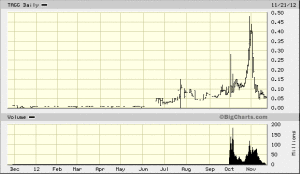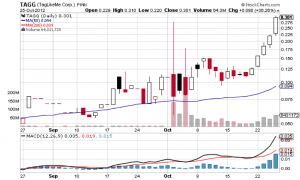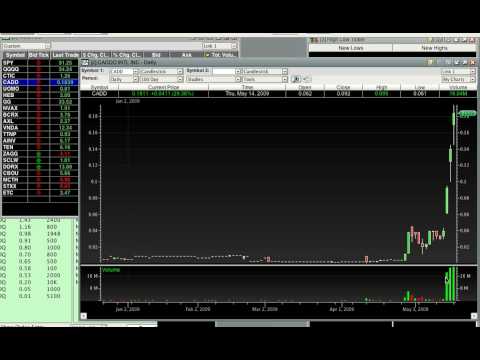I’ve been spending more and more time with my students, particularly with my trading challenge students all in an effort to create a millionaire from scratch, as I detailed in this blog post and you might’ve noticed, my blogging productivity has gone down the drain.
The good news is that my students are now becoming so masterful that they’re beginning to teach others now too…just like this trading challenge student who helped the rest of my students make $50,000 in one day.
A student who turned just over $1,000 into $120,000+ in one year (def click that link, it’s an amazinggggg story!) sent me this email while he was in Thailand!!!
Tim, head’s up, TAGG is ETB right now. Not sure if you saw that, since TAGG wasn’t on your watchlist. Just thought I’d give you a heads up, definitely something to keep an eye on
The stock tanked soon after and he was dead on, even while he was on vacation! I shoulda coulda woulda listened to him, but I was busy helping another student at the time.
Another student wrote this great guest post for me on that pump and dump before it crashed to this chart:

…which I should’ve posted sooner, I’ve just been slammed lately:
TAGG Retrospective and Clues for the Future
I think most people were hoping that Awesome Penny Stocks would get their groove back. The last few picks have been disappointing when you compare them to earlier in the year. The current one TAGG is no NSRS, SNPK, or GWBU. Those were more or less in sequence so it is not like APS needs time to sit down and catch its breath.
It might be too soon to say if a new pattern has emerged, but it might be prudent to be cautious. In the past it was okay to just wait for confirmation, and if you are a long player you could hop in at that point. If you like to short these you can sit and wait for one of those big zero day peaks and then short all the shares you can find.
More Breaking News
- CNH Stock: Is It Time to Buy?
- Datadog’s Market Surge: What’s Driving the Momentum?
- D-Wave Quantum’s $400 Million Boost: What’s Next?
In the past the peak and trough cycle in APS picks worked on larger timescales. The first day of TAGG was gripping, and ended up down. That is not a traditional APS maneuver. Let’s say that they are changing it up because people are wise to their methods. The next day it was up a bit. Then it was down again the day after. Only in the last few days has it started to show real results from the pump portion of a classic pump and dump.
It really does seem like the recent rise is from standard continuation emails, of which I have received many. The last few days they have all claimed $1, which seems like those last stragglers promoters send out when a promotion is winding down. It makes me wonder if the recent rise is due to support from the promoters or from email recipients who still hold hope that APS can pull off a miracle.
The problem for both longs and potential shorts is that there might be too much uncertainty. If you sense a peak and decide to short all the shares you see the new stratagem might be to wait till the very end for a last hurrah for TAGG to improve their past record. Obviously, shorting at that point would be great. There are no guarantees in the penny world.
APS picks do not seem to trade like they used to. They used to be rock stars, but now they carry this massive risk. The risk is not that it is a pump and dump, but its history of success. People’s expectations lead them down the tried and true path of buying and holding onto APS. Shorts wait for dizzying highs. Hoping for those massive gains keeps you from more lucrative smaller gains. However, you cannot just jump in unless you have a crazy high risk tolerance, which is not necessarily a good thing.
If you short at the wrong time you might be caught in one last big upswing. Even if it is a death rattle it could eat your account. At least when you short you have the comfort of knowing a successful pump is followed by a subsequent dump. The point is not to be colored by your expectations. You need to throw out the APS playbook, and start from scratch.
There is no shortage of promotions out there, and it might be prudent to just watch APS, while you look at other promotions. Even now with the close at $0.301 it is right around the first day spike. A godsend for those who bought at the first day spike and had the despondence to hang on. The volume has been comparatively weak compared to the early days. With red bars commanding the largest volume it makes you wonder how this promotion is being handled. I know most expect more from APS on the long and short side, but Rome may have fallen.
Avoiding uncertainty is always important, because patterns are the greatest tool of the trader. If you cannot predict how something will play out with a reasonable degree of certainty, then you should turn away. When things with established patterns suddenly change everyone should pay attention. Not changing with the pattern is the difference between success and ruin. No one can tell the future. Standard technical analysis on penny stock promos is frustrated by the fact that there is an invisible player with capital and shares to mold the stock to its designs. Market dynamics are not at work alone.
Always be aware of the role that the promoters themselves play in running something like NSRS. It is never so simple as sending out an email and hoping that it performs well. If that were true then every play would be an all out winner. Perhaps for whatever reason APS is taking a different strategy for its new picks. Either way, it might be time to step back and evaluate the strategy you use for them. Seems like the long way to tell you to engage in critical evaluation of your expectations and strategies, but it is important to roll with the punches. As traders, long or short we are simply players on the board. We do not control the entire game.










Leave a reply